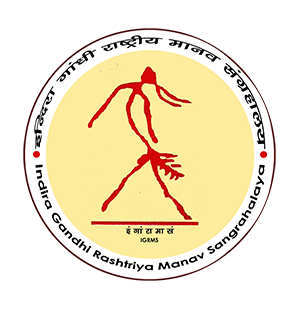भुंगा
संग्रहालय की मरुभूमि मुक्ताकाश प्रदर्शनी में निर्मित गुजरात के यायावर जनसमूह रबारी के पारंपरिक आवास भुंगा का संकुल अपने आकर्षक गोलाकार एवं शंक्वाकार छाजन तथा चित्ताकर्षक भीतरी सज्जा के चलते बरबस ही दर्शकों का मन मोह लेते हैं।
भारत के पश्चिमी तटवर्ती प्रांत गुजरात की सांस्कृतिक पृष्ठभूमि को वैविध्य प्रदान करने में जितना महत्व वहाँ की जलवायु और दोहरी भौगोलिक स्थिति का है उतना ही वहाँ पर रहने वाले जनजातीय एवं लोक समूहों का भी है।
पर्यटकों और अनुसंधानकर्ताओं के आकर्षण का केंद्र रहे इस क्षेत्र में सदियों से अपनी सीमित जीवनोपयोगी गतिविधियों के साथ बसने वाले मेहनत कश और सहनशील जनसमूहों में रबारी एक प्रमुख समुदाय है। अर्ध घुमंतू पशुपालक रबारी का शाब्दिक अर्थ राह बाहरी या मूल से परे रहने वाले समूह से है, जिससे जुड़ी कई रोचक मिथक कथाएँ भी प्रचलित हैं, जिनमें वर्णित तथ्यों की पुष्टि आज भी रबारी जीवन और रहन-सहन में होती है।
गुजरात, राजस्थान, आन्ध्रप्रदेश, महाराष्ट्र तथा मध्य प्रदेश तक फैले रबारी अपने खास पारंपरिक पहनावे, शंक्वाकार छत और गोलाकार अधो-संरचना वाले आवास प्रकार- भुंगा तथा असंख्य कलात्मक गतिविधियों के कारण सहज पहचाने जा सकते हैं। रबारियों की उत्पत्ति के संबंध में आंशिक अंतर के साथ प्रचलित मिथक कथाओं के अनुसार रबारियों की उत्पत्ति संबल नामक पशुपालक (ऊंट चराने वाले) तथा देव कन्याओं (अप्सराओं) की चार पुत्रियों के राजपूतों के साथ विवाह करने और एक पृथक जाति समूह (रबारी) की स्थापना करने से हुई।
पशुओं के इर्द-गिर्द बुने रबारी जीवन चर्या के ताने-बाने में ऊंट का प्रमुख स्थान है। रबारी अपनी जीविका पशु अथवा पशु उत्पादों जैसे- दूध, दूध से बने पदार्थ, ऊन आदि बेच कर कमाते हैं। रबारी अर्थव्यवस्था पशुपालन पर निर्भर है अतः एक स्थान पर उनके पड़ाव की अवधि चारागाह की उपलब्धता पर निर्भर है। कच्छी रबारी अब काफी हद तक स्थिर हो चुके है। पूर्वी कच्छ में वागड़िया रबारी आज भी अपनी पारंपरिक यायावर जीवन शैली के पक्षधर हैं। छोटे-छोटे समूहों में स्थानांतरण करने वाले वागड़िया रबारियों के पड़ाव किसी कुएं अथवा नदी के किनारे लगते हैं। समूह के वृद्ध सदस्य गाँव में ही रहते हैं। चारपाई, खाना बनाने के बर्तन, कंबल, पानी के बर्तन, मेमने और नवजात ऊंट आदि सीमित गृहस्थी के साथ युवा स्थानांतरित होते रहते है। पड़ाव डालने के बाद पुरुष पशु लेकर चरागाह निकाल जाते हैं तथा महिलाएं पीछे रह गए नवजात पशु शावकों की देखभाल सहित घरेलू कार्य और कलात्मक गतिविधियां संपादित करती है।
रबारी महिलाओं के सौन्दर्य बोध और कलाकौशल की अनुभूति उनके पहनावे सहित बुनाई और कशीदाकारी में होती है। एक रबारी बालिका लगभग छः वर्ष की आयु से ही कशीदाकला का अभ्यास करने लगती है और परिवार की वयस्क महिलाओं के मार्गदर्शन में निपुणता प्राप्त कर लेती हैं तथा निजी उपयोग व घरेलू सजावट के साथ-साथ अपने विवाह के लिए विभिन्न कढ़ाई युक्त वस्तुएं स्वयं तैयार करती हैं।
पहनावा, जीवन शैली, सामाजिक परंपरा और रीति-रिवाजों की तरह रबारी आवास प्रकार भी विशिष्ट है। घास फूस से आच्छादित शंक्वाकार छत और वृत्ताकार अधो संरचना वाले अतिसाधारण परंतु अत्यंत उपयोगी ‘भुंगा’ कहलाने वाले आवास-प्रकार रबारी गांवों की पहचान है। मिट्टी और गोबर से बने गोलाकार भुंगा में एक ही कमरा होता है। छत पेड़ों के तने व मोटी-मोटी शाखाओं के बीच पत्तों और घास की छाजन तैयार कर बनाई जाती है, जिसे मिट्टी और गोबर से छाप कर जलरोधी बनाया जाता है तथा एक और परत घाँस की छाजन डाली जाती है। भीतरी दीवारों से लगी बहुउपयोगी कोठियाँ (वृत्ताकार) कोठले (चौकोर) बनाए जाते हैं। गोबर और मिट्टी से ही बने ये कोठी और कोठले रबारी महिलाओं के सौन्दर्य बोध एवं कलाकौशल के परिचायक है। घर की बाहरी दीवार तथा कोठियों आदि पर काँच और मिट्टी से विविध आकृतियाँ उकेर कर रबारी महिलाएं अपनी कलात्मक अभिरुचि को व्यक्त करती हैं।
Bhunga
Traditional dwelling complex Rabari, the semi-nomadic community of Gujarat built in the Desert Village open air exhibition of Museum simply enthrals visitors by its attractive round shape, conical roof and beautiful interior decoration.
The cultural diversity of western coastal state of India, Gujarat is the result of its climate and geographical location as also of interaction between tribal and folk communities. Rabari is one of the main community who is living in this area for centuries in search of their livelihood. Semi nomadic pastoralist group Rabari has many myths explaining their origin which are reflected in their lifestyle.
Spread in Gujarat, Rajasthan, Madhya Pradesh, Andhra Pradesh and Maharashtra states of India, the Rabaris can be indentified easily through their unique dress, round structured, conical roof house- Bhunga and several artistic activities. According to mythology stories prevalent with partial differences regarding the origin of the Rabaril, the Rabari originated from the marriage of four daughters of herder(camel grazing) and deva kanyas (apsaras) with Rajputs and establishing a separate caste group (Rabari).
The Camels have a special place in their economy. They sell animals and animal products such as milk and milk related products for their livelihood. The Rabari Economy is dependent on animal husbandry so the duration of their stay at one place depends upon the postures. Kutchi Rabari are now living more sedentary life. Vagadia Rabari in eastern Kutch are still in favour of their traditional nomadic lifestyle. Migrating in smaller groups Vagadia Rabaris stop on the bank of a river or well for camping. Older people stays in the village while the young people move with limited household items like cooking utensils, cots, blankets, lambs and camels.
During the camping at one place the men take the animals for pastures and the women stays from performing domestic work, taking care of new born animals and artistic activities. Rabari women’s aesthetic and art skills can be seen in weaving and embroidery work. A Rabari girl starts practicing embroidery from the age of about six years and masters the art in guidance of elderly women in the family and prepares various embroidered items for her marriage along with items for personal use and household decorations..
Like dress, lifestyle, social traditions and customs, the Rabari house-type is also unique. The most common but very useful ‘Bhunga’ house type with a conical roof and circular walls is the identity of Rabari villages. Made of clay and dung the Bhunga has only one room. The roof is made by preparing layers of leaves and grass between the trunks of the trees and the thick branches. This is covered with soil and dung to make it waterproof then another layer of grass is placed on it. Made of dung and clay, this Kothi and Kothle denotes the aesthetic sense and art skills of Rabari women. They also make various motifs from glass and clay on the outer wall and storage spaces inside the house etc.



